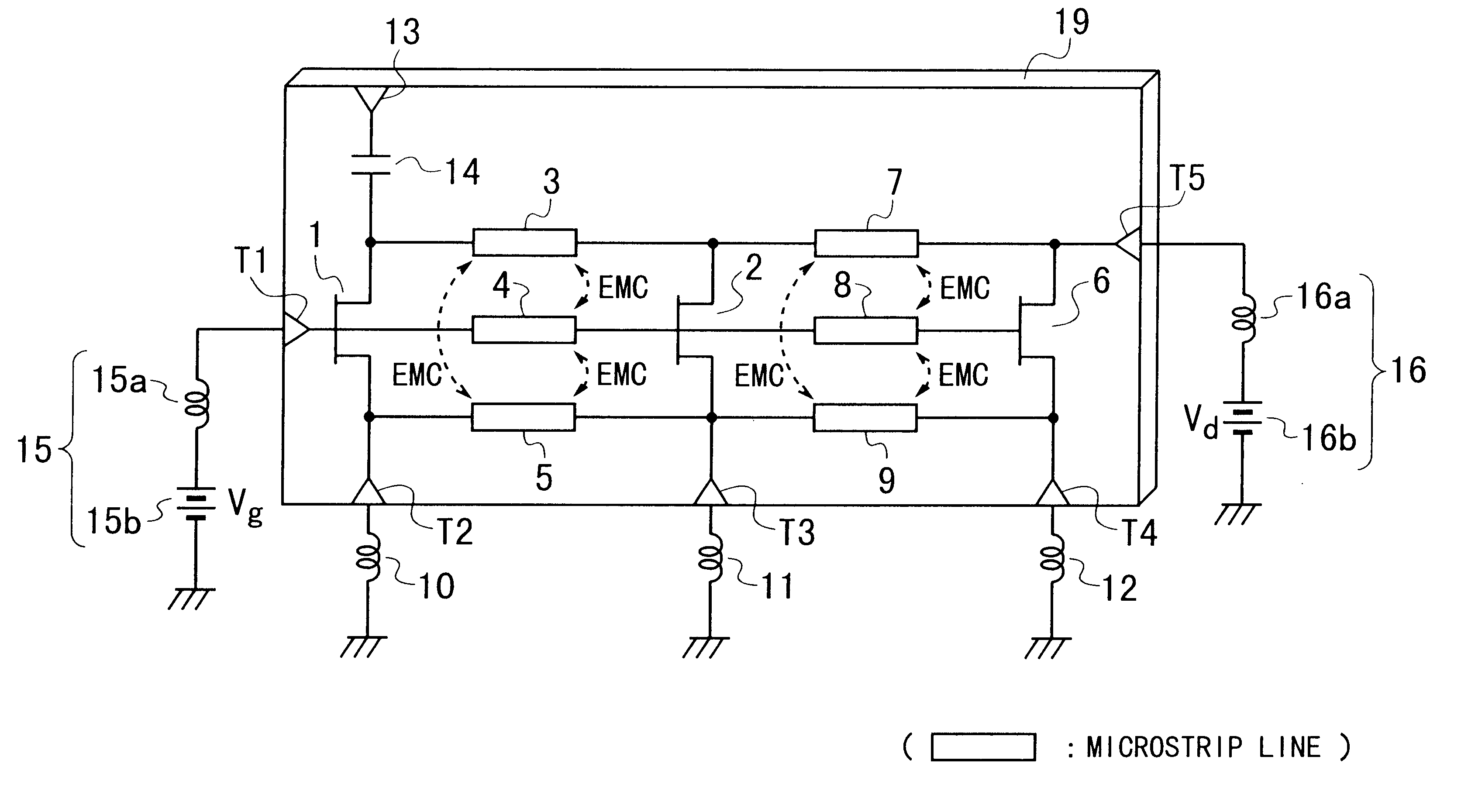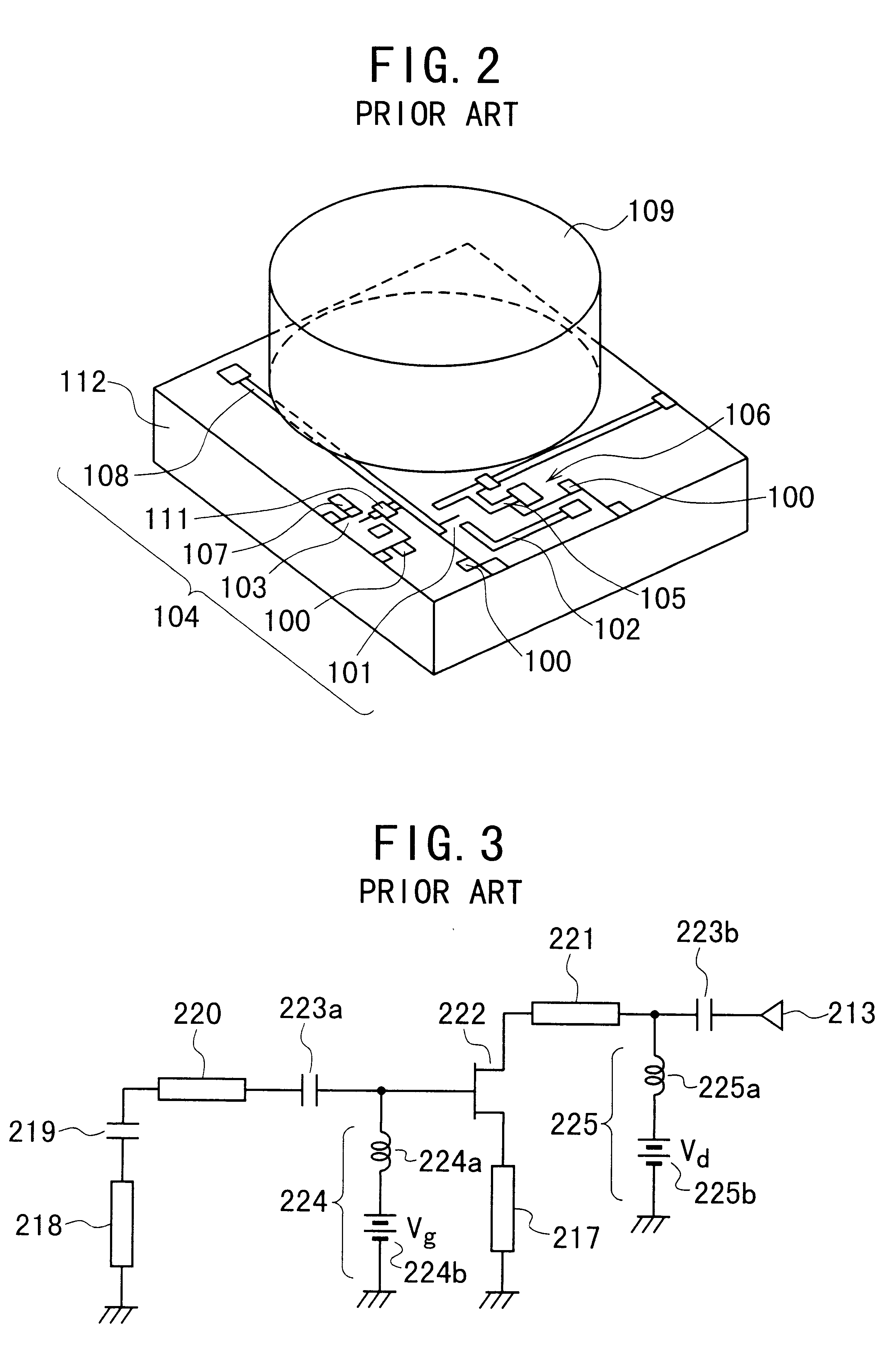High-frequency oscillator using FETs and transmission lines
a transmission line and high-frequency oscillator technology, applied in the direction of oscillator generators, pulse techniques, semiconductor/solid-state device details, etc., can solve the problems of difficult control of 1/f noise, 1/f noise, phase error tends to occur between the input and output of the
- Summary
- Abstract
- Description
- Claims
- Application Information
AI Technical Summary
Problems solved by technology
Method used
Image
Examples
first embodiment
A high-frequency oscillator according to the invention has the circuit configuration as shown in FIG. 7.
As seen from FIG. 7, the oscillator comprises three FETs 1, 2, and 6 and six transmission lines 3, 4, 5, 7, 8, and 9, which are formed on a GaAs substrate 19. Each of the lines 3, 4, 5, 7, 8, and 9 is formed by a microstrip line. The lines 3, 4, and 5 are arranged in parallel on the substrate 19 and electromagnetically coupled with each other. In other words, the lines 3, 4, and 5 are coupled together due to the electromagnetic field. Similarly, the lines 7, 8, and 9 are arranged in parallel on the substrate 19 and electromagnetically coupled with each other. In other words, the lines 7, 8, and 9 are coupled together due to the electromagnetic field.
The gate of the first FET 1 is connected to a corresponding end of the transmission line 4. The gate of the first FET 1 is further connected to one terminal of a gate bias circuit 15 through an interconnection terminal T1. The other te...
second embodiment
FIG. 10 shows a high-frequency oscillator according to a second embodiment of the invention, which has the same configuration as that of the first embodiment except that transmission lines 26, 27, and 28 are used instead of the inductors 10, 11, and 12 in the first embodiment. Accordingly, the explanation about the same configuration is omitted here for simplification of description by attaching the same reference symbols as those used in the first embodiment in FIG. 10.
As shown in FIG. 10, the transmission lines 26, 27, and 28 are microstrip lines formed on the GaAs substrate 19. The line 26 is connected to the source of the first FET 1 and the interconnection terminal T2. The line 27 is connected to the source of the second FET 2 and the interconnection terminal T3. The line 28 is connected to the source of the third FET 6 and the interconnection terminal T4.
To examine the performance of the oscillator according to the second embodiment of FIG. 10, the inventor carried out simulat...
third embodiment
FIG. 13 shows a high-frequency oscillator according to a third embodiment of the invention, which has the same configuration as that of the second embodiment except that an alumina (Al.sub.2 O.sub.3) substrate 39 is used instead of the GaAs substrate 19 in the first embodiment. Accordingly, the explanation about the same configuration is omitted here for simplification of description by attaching the same reference symbols as those used in the second embodiment in FIG. 13.
As seen from FIG. 13, because of the substrate 39 is dielectric, the first to third FETs 1, 2, and 6 are formed by discrete transistors 31, 32, and 33, respectively. The capacitor 14 also is formed by a discrete capacitor component 34. The transistors 31, 32, and 33, and the capacitor component 34 are mounted on the substrate 39 by the well-known flip-chip bonding technique.
To examine the performance of the oscillator according to the third embodiment of FIG. 13, the inventor carried out simulation in the same mann...
PUM
 Login to View More
Login to View More Abstract
Description
Claims
Application Information
 Login to View More
Login to View More - R&D
- Intellectual Property
- Life Sciences
- Materials
- Tech Scout
- Unparalleled Data Quality
- Higher Quality Content
- 60% Fewer Hallucinations
Browse by: Latest US Patents, China's latest patents, Technical Efficacy Thesaurus, Application Domain, Technology Topic, Popular Technical Reports.
© 2025 PatSnap. All rights reserved.Legal|Privacy policy|Modern Slavery Act Transparency Statement|Sitemap|About US| Contact US: help@patsnap.com



